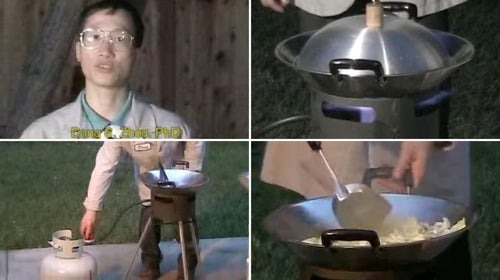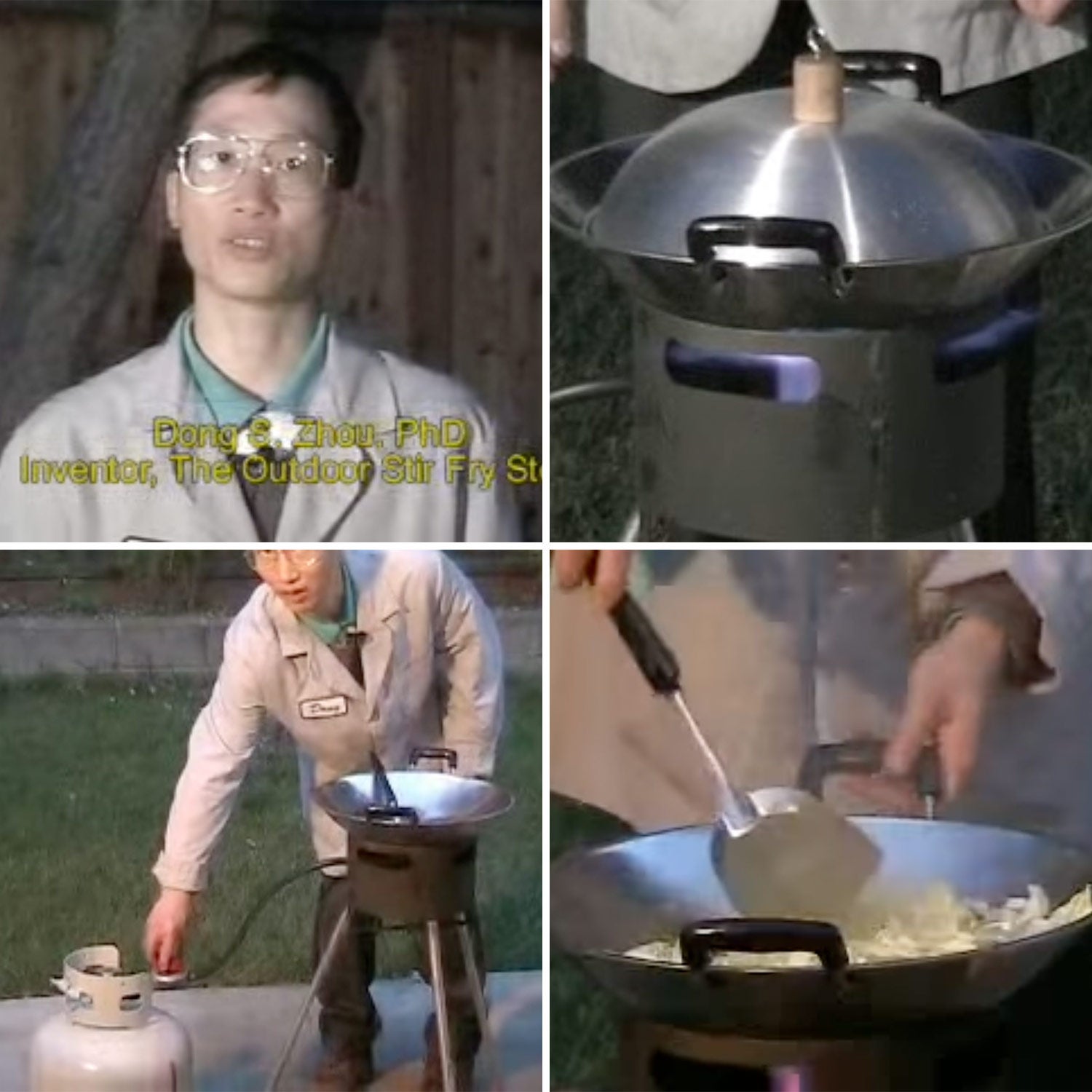In Chinese cooking, achieving the elusive wok hei flavor can be challenging, especially for home cooks. ItтАЩs not a seasoning that comes in a bottle, and it canтАЩt be extracted from a spice. Literally translated as тАЬbreath of the wok,тАЭ wok hei is the intense smoky╠¤char you might discern in a plate of fried rice or chow mien.
Turns out thereтАЩs a science to it. According to published in 2020 in the Journal of the Royal Society Interface, wok hei is enabled by the Maillard reaction, a series of chemical reactions that take place when proteins and sugar are transformed by heatтАФreally high heat of at least 1,832 degrees Fahrenheit. Until recently, only commercial kitchens were equipped with restaurant-grade stoves capable of delivering such intense firepower, as well as industrial-size exhaust hoods to filter out the grease and fumes it produces.
Food writer and cookbook author J. Kenji L├│pez-Alt had spent more than a decade trying to discover the elements of a legit wok hei flavor in his home kitchen. Last year, in his , he declared PowerFlamer 160EI the best outdoor wok burner and the one that тАЬproduced the smokiest wok hei.тАЭ L├│pez-AltтАЩs review lit a fire under hardcore foodies, who have started to snap up PowerFlamers minutes after theyтАЩre made available on the companyтАЩs . (Thanks to the review and pandemic supply-chain issues, thereтАЩs currently a six-to-12-month waiting list.)
While PowerFlamerтАЩs popularity might seem like an overnight success, the productтАЩs creators, Dong Zhou and Michael Loth, worked on perfecting an outdoor wok stove for more than 25 years. After Zhou and his wife moved to the U.S. from China in 1991, he was disappointed that he was not able to re-create his favorite stir-fries in their small Oregon apartment. His dishes lacked the wok hei. Plus, whenever he cooked, the smell of smoke would cling to their clothes, curtains, and bedsheets for days. тАЬWe went to sleep with the smoke. Those small apartments were not very well ventilated,тАЭ he recalls. тАЬWhen we moved out of that apartment, the filter was actually dripping oil.тАЭ The couple relocated to Cleveland before settling down in Wisconsin in 1996.
An avid cook, Zhou continued to refine his stir-fry technique. But without a strong enough stove, his dishes always ended up soggy, overcooked messes. Determined to find a solution, he went to the local hardware store and bought an outdoor deep-fryer stove and a wok set. тАЬThe first time I cooked with the outdoor stove, I burned my fingers,тАЭ he says.╠¤ThatтАЩs when he turned to a coworker at Rockwell Automation in Milwaukee, Michael Loth, a fellow electrical engineer who had a machine shop in his basement. тАЬI had never heard of such a thing as an outdoor wok stove before,тАЭ Loth says. тАЬBut my wife had an indoor electric wok, and I knew how the oil and smoke could get all over the kitchen walls.тАЭ Together, Loth and Zhou tested different burners and made modifications. тАЬWe experimented with outdoor turkey deep-fryer burners, but they did not work well with a wok,тАЭ Zhou says. тАЬThe burner guard was a challenge also. We needed something to put the wok on and keep the wind out of the burner at the same time.тАЭ
After months of research and experimentation, Loth and Zhou came up with a design that distributed heat evenly and, more important, didnтАЩt burn ZhouтАЩs hands when he tried to cook. To commemorate the occasion, Zhou prepared shrimp and vegetables for the LothsтАФa memorable meal that MichaelтАЩs wife declared was the best food sheтАЩs eaten.
In 2000 ZhouтАЩs wife graduated from her PhD program and the couple moved to California. In order to pay for the cost to patent the outdoor stove, ZhouтАЩs friend (and eventual business partner) Alex Zhang suggested that he start selling the product. In May 2008, Zhou launched a to promote his outdoor burners. His first videos were a series of cooking demos, from to sweet-and-sour pork. Lanky, bespectacled, and sporting a buttoned-up polo shirt and jacket, Zhou is more refined engineer than rugged outdoorsman, and his early videos were a cross between PBS cooking show and childrenтАЩs science program. Despite his efforts, the PowerFlamer wasnтАЩt an immediate hit. An outdoor wok burner was not a common appliance, even in Asian countries.
Zhou and Loth continued to make improvements to the stove, adding a pilot light and making the stove more powerful and suitable for home backyard cooking. The latest version, the PowerFlamer 160EI, released in 2018, boasts 160,000 BTUs, four times more than a regular indoor gas range puts out. ThereтАЩs a built-in heat guard around the central burner, so your fingers are protected from the flames. The gas-control valve is easily accessible, making heat adjustments convenient. Over the years, PowerFlamer has slowly gained a steady fan base of home cooks.
тАЬMy partner had always wanted to cook with a wok after seeing how chefs cook with those jet-engine-like burners in Chinese restaurants,тАЭ says Stephanie Gott, a dedicated home cook in New Mexico. тАЬBecause you generally need very high heat to cook with a wok, he researched ways you could have an at-home setup similar to the burners they use.тАЭ He came across the PowerFlamer at outdoorstirfy.com through a Google search; to get his hands on the in-demand tool, he woke up at 7:30 each morning and hit the refresh on the web page тАЬa bajillion timesтАЭ before getting lucky. The setup was easyтАФinstalling a couple of screws for the legs and hooking it up to a propane tank. But Gott says there was a bigger learning curve when trying to cook in a wok. тАЬHigh-quality woks are made of thin carbon steel, so the pan heats up and cools down very quickly,тАЭ Gott says. тАЬWeтАЩve been mostly cooking on cast iron in the past, which is the complete opposite.тАЭ Eventually they mastered the facets of wok cookingтАФwhen to add certain ingredients, when to add the sauce, how to move the ingredients around, and the right technique to achieve the wok hei essenceтАФthrough watching YouTube videos.
Now Gott and her partner prefer using the PowerFlamer over a traditional grill when hosting small outdoor dinner parties. тАЬCooking with a wok is great because of the variety of things you can cook on it. WeтАЩve made fried dishes like laziji chicken, stewed dishes like chicken adobo, stir-fries like Thai basil chicken, all kinds of fried rice, and even sopapillas with it once,тАЭ she says. тАЬMy favorite so far is probably any of the stir-fries or fried ones because of how fast you can make them.тАЭ
ZhouтАЩs hope is that one day thereтАЩll be a PowerFlamer next to a Weber Grill in everyoneтАЩs backyard. тАЬOur vision is to bring commercial-grade appliances to the household, just like how Steve Jobs adapted commercial mainframe computers into personal ones,тАЭ Zhou says. тАЬHaving a powerful set of stir-frying equipment outdoors enriches peopleтАЩs lives. All great dishes available from great Asian restaurants can now be re-created by regular homeowners like you and us.тАЭ


